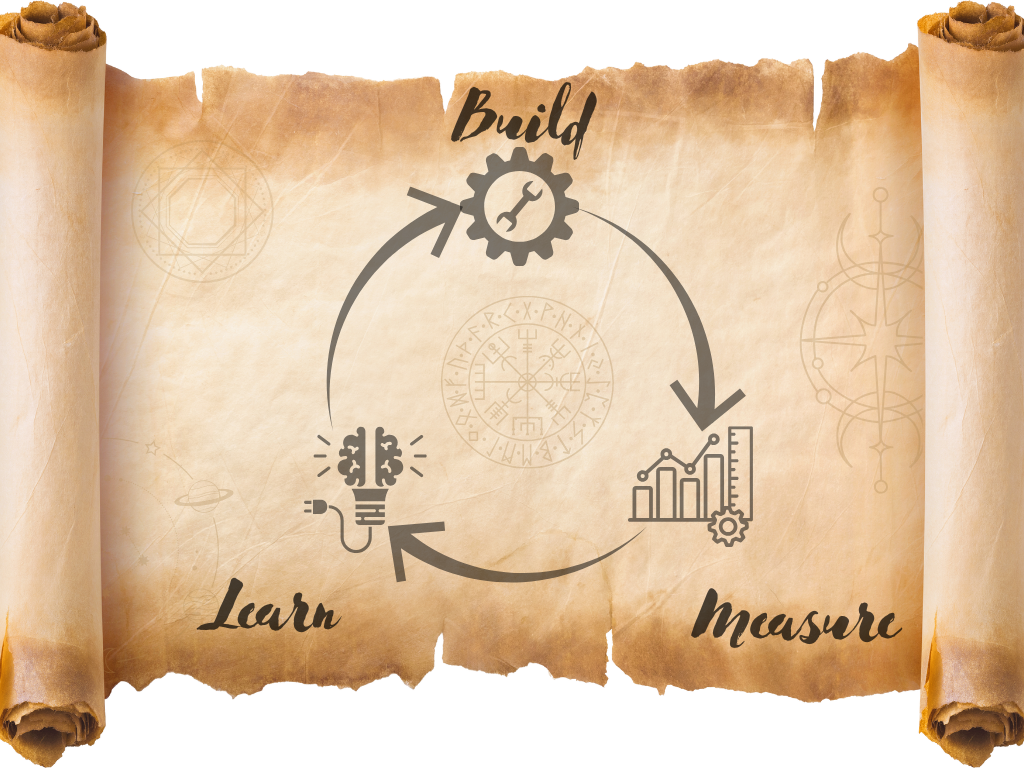In the realm of Byz Ness, there was a famous sage known as Eric.
Eric once spoke of a mystical concept he called the MVP: a strategy so potent that even a humble merchant could outwit powerful guilds if used wisely.
Though it may seem like pure wizardry at first, this principle can be found right here in our modern world of startups and business ventures.
In this tale, we’ll journey through a brief tale and a very real explanation of how an MVP can help you bring your product idea to market with minimal risk and maximum learning.
The Magic Scroll

Our tale begins with a traveling merchant named Arden, who came upon a rumor of a Magic Scroll said to hold a single but crucial enchantment. Unlike the heavy tomes of spells used by grand sorcerers, this Scroll contained only the most basic version of the enchantment. While many scoffed at its apparent simplicity, Arden recognized its true power: it was all that was needed to prove the spell could work at all.
In the world of business, this parallels Eric Ries’s idea of the Minimum Viable Product (MVP): the simplest, core version of your product or service that allows you to test your idea in the marketplace. You don’t need all the bells and whistles. You just need enough to see whether your magic resonates with real users.
The Essence of the Scroll (Defining the MVP)
- Core Functionality: In this tale, the Magic Scroll had just one enchantment, no fancy illusions, no complicated summoning spells. Similarly, your MVP should focus on the single, most important function of your product or service. What is it supposed to accomplish at its heart?
- Early Feedback: Once Arden tested the Scroll on a few villagers, he learned whether the spell was truly helpful or if it needed more refinement. In the real world, by offering customers a minimal but functional version of your product, you can learn from their reactions quickly, without wasting time or gold on unwanted features.
Why Start with the Basics?
- Avoid Overbuilding: In RPG terms, you might waste precious resources forging an elaborate sword with runes and gems only to discover the kingdom needs a spear for its battles. In modern business, building unnecessary features can cost you in time, money, and missed opportunities.
- Learn on the Go: Release early, learn swiftly, and improve continuously. The MVP mindset fosters an agile approach, much like a seasoned ranger adapting to new terrains rather than lugging around an entire armory of solutions.
The Journey of Validation

Arden’s journey demanded he gather feedback from various towns. Some villagers loved the scroll’s enchantment, while others offered critiques that sparked new ideas like adding a protective charm or an instant teleportation spell. This loop of testing and improving led Arden to refine his Scroll enchantments one step at a time.
In business, this process is often referred to as the Build-Measure-Learn cycle:
- Build: Craft your MVP (the core product).
- Measure: Release it to real customers or users, and gather their feedback.
- Learn: Use that feedback to refine your product, focusing on features people actually want.
Scaling the Magic

Once the Scroll’s single enchantment proved helpful, Arden began to add carefully chosen improvements. These new spells attracted more allies and opened new markets. Before long, merchants far and wide sought Arden’s refined Scroll, no longer just a prototype, but a polished solution that solved a real need that had grown alongside genuine user insights.
Once your MVP is validated, then you can scale:
- Enhance the Product: Introduce additional features based on user feedback.
- Broaden Your Customer Base: Expand your market reach, confident in the knowledge that the product solves a real problem.
- Iterate Continuously: Even as you grow, keep the MVP mindset. Test changes in small, controlled increments.
The Magic of Minimizing Risk
The story of Arden’s Magic Scroll offers a valuable lesson for innovators, entrepreneurs, and leaders alike. By building only what’s necessary at first and using feedback from real users to guide improvements, you minimize risk and maximize learning; a strategy that can save you countless coins (and potential heartbreak) when launching a new product.
Eric Ries’s Minimum Viable Product approach outlined in his book The Lean Startup might not grant you the power to conjure dragons or part seas, but it does give you something even more tangible: a proven path to understanding your customers’ real needs.
Rather than unveiling a grand, untested masterpiece, start small, like a humble magic scroll, and invite the world to tell you exactly what it wants next. In both the kingdom of Byz Ness and our modern entrepreneurial landscape, that’s the surest way to forge success from a single, brilliant spark.

Key Takeaways from the Scroll’s Saga
- Start Simple: Resist the urge to overcomplicate your product in the beginning.
- Seek Real Feedback: Release your MVP to a small group of real users or customers.
- Iterate Quickly: Use the Build-Measure-Learn cycle to refine your offering based on genuine insights.
- Scale Strategically: Add features gradually, ensuring each addition is truly desired by your audience.
Want to continue the tale?
Check out the Lean Startup by Eric Reiss here:
https://www.amazon.com/Lean-Startup-Entrepreneurs-Continuous-Innovation/dp/0307887898

Leave a Reply